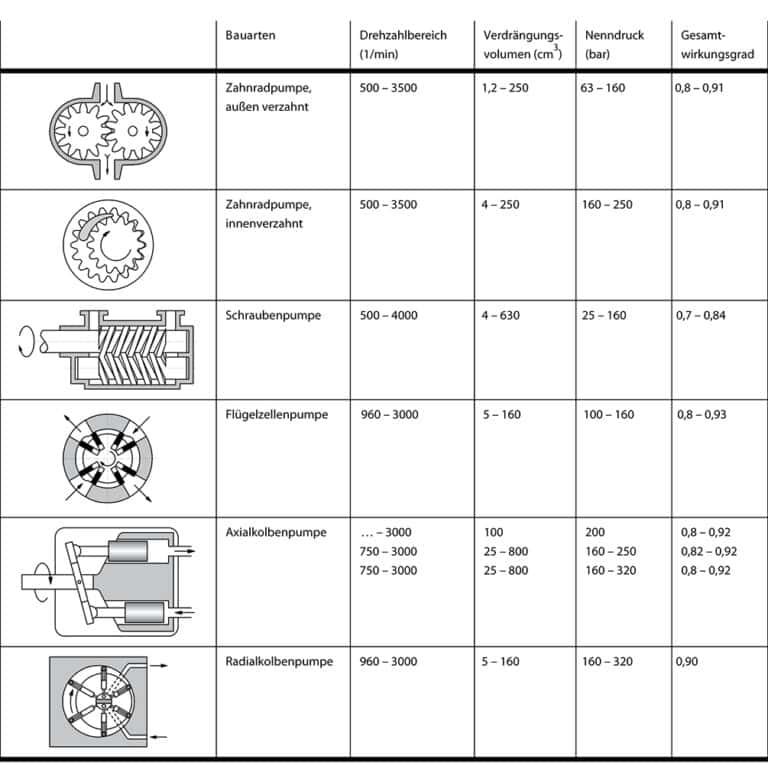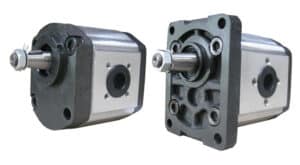The hydraulic pump - the heart of the hydraulic system
What you should know about hydraulic pumps
Hydraulic pumps convert the mechanical energy provided into hydraulic energy. A distinction is made between constant and variable displacement pumps. Constant pumps deliver a constant volume of oil depending on the drive. The amount of oil can only be regulated by valve technology (quantity control valves) or regulation of the drive (e.g. frequency regulation of the electric motor, speed regulation of the diesel engine). Hydraulic variable displacement pumps have the option of changing the delivery volume, independently of the drive unit. The adjustment can be hydraulic, electrical or mechanical.
Content

There are a few important criteria to consider when selecting hydraulic pumps:
• Application
• Operating medium (hydraulic oil, HFC fluid, gear oil)
• Necessary pressure range
• Speed range in which the pump is operated
• Installation situation
• Noise level
• Price
Hydraulic pumps usually work according to the so-called displacement principle. This creates mechanically sealed chambers in the pump. In these chambers, liquid is conveyed from the suction port to the pressure port of the pump.
Calculation of a hydraulic pump
The most important parameter for hydraulic pumps is the displacement volume V (also known as displacement volume or stroke volume). V is a measure of the size of the pump. It describes the volume of liquid that is delivered by the pump per revolution (or per stroke).
Efficiency:
Mechanical power is converted into hydraulic power by pumps, resulting in power losses that are expressed in terms of efficiency. When calculating the overall efficiency of pumps, the volumetric (η Vol ) and hydraulic-mechanical efficiency (η hm ) must be taken into account. The following applies:
η tot = ηv ol + η hm
The volume of liquid conveyed per minute is referred to as volume flow Q (flow rate). The overall efficiency must be taken into account when calculating the pump delivery flow Q. This results from the displacement volume V and the speed n:

Another important parameter is the required drive power of the hydraulic pump. Depending on the consumer used, this calculates the required power of the drive unit (electric motor, combustion engine, PTO gear):

The drive torque required for the hydraulic pump is calculated as follows:

There are:
- Q Conveyor[l/min] : displacement of the hydraulic pump
- m on[Nm] : drive torque
- p[bar] : Operating pressure
- vgeo[cm³/U] : Geometric displacement of the hydraulic pump
- n[U/min] : drive speed
- η Vol : volumetric efficiency (approx. 0.9 – 0.95)
- η mh : mechanical hydraulic efficiency (0.9 – 0.95)
- η total : overall efficiency (0.8 – 0.85)
How are hydraulic pumps driven?
A hydraulic pump can be powered in a number of ways. A common type of drive is a power take-off gear to which the pump is flanged. Other types of drive are electric motors (electrohydraulic pump) or internal combustion engines. In tractors, the hydraulic pump is usually driven in the power take-off.

What types of hydraulic pumps are there?
The most common type is the gear pump. This is used in many applications, such as agricultural engineering, construction machinery, hydraulic units, log splitters and many more and is available in various flange and shaft designs. Gear pumps with an aluminum housing are generally suitable for pressures of up to 280 bar. There are axial piston pumps for open and closed hydraulic circuits. These piston pumps are available in so-called swash plate and bent axis designs. Axial piston pumps can be operated at high speeds and are also suitable for pressures of up to 450 bar. Other types of hydraulic pumps are, for example, vane pumps and radial piston pumps. These are often found in industrial applications such as in plastic injection molding machines or test benches.

Which hydraulic oil is suitable for hydraulic pumps?
The use of the appropriate hydraulic fluid is relevant for smooth operation of the hydraulic system. We recommend using hydraulic oil with viscosity ISO VG 32 or ISO VG 46 (HLP32 or HLP46). Other hydraulic media (such as bio-oils) can also be used after consultation.
How much does a hydraulic pump cost?
The cheapest hydraulic pump is the gear pump. But that doesn’t mean that this pump is worse than other pumps. The low price is due to the comparatively simple design and the large quantities that are produced by this type of pump. Gear pump prices start at around 50 euros. Axial piston pumps are significantly more expensive. Large axial piston pumps can quickly be in the mid four-digit range.
More information about hydraulic pumps

gear pumps
Hydraulic Gear Pump – 5 things you should know Hydraulic gear pumps convert the mechanical energy provided into hydraulic energy. A distinction is made between
You can buy hydraulic pumps in our online shop!
In our webshop you will find an extensive selection of hydraulic pumps such as gear pumps, axial piston units or hand pumps!